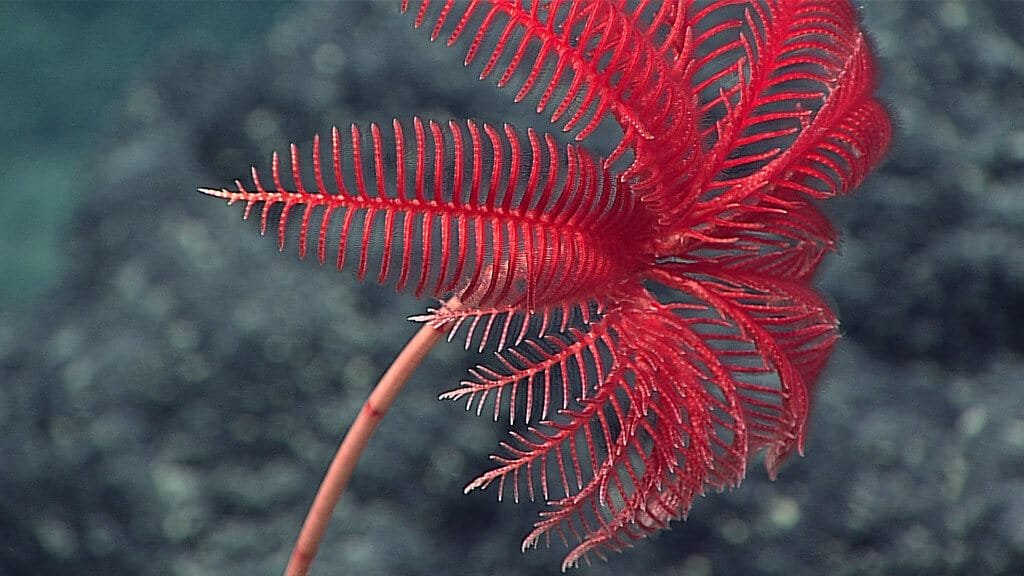Discovering Sea Lilies: The Ancient Echinoderms
Sea lilies, with their elegant, feather-like arms and fascinating history, are among the most ancient and captivating inhabitants of the marine world. These ancient echinoderms, belonging to the class Crinoidea, are closely related to starfish, sea urchins, and brittle stars. This article delves into the appearance, behaviour, and care requirements of sea lilies in a reef aquarium.
What Are Sea Lilies?
Sea lilies, also known as crinoids, are marine animals that have existed for over 480 million years, making them one of the oldest groups of echinoderms. They are found in oceans worldwide, from shallow coastal waters to the deep sea, and come in a variety of colours and forms.

Key Characteristics:
• Appearance: Sea lilies have a central body known as the calyx, from which multiple feather-like arms extend. These arms can vary in colour, often displaying vibrant hues of red, yellow, and orange, as well as more subdued tones like white and brown.
• Size: Depending on the species, sea lilies can have arm spans ranging from a few inches to several feet.
• Anatomy: Their arms are covered in tiny, hair-like structures called pinnules, which they use to capture food particles from the water.
Fascinating Adaptations and Behaviours
Sea lilies possess several unique adaptations and behaviours that enable them to thrive in their natural habitats:
1. Feeding Mechanism:
• Sea lilies are suspension feeders. They use their feather-like arms to capture plankton and organic particles from the water. The pinnules on their arms are coated with mucus, which traps food particles. These are then transported to the mouth located on the calyx.
2. Locomotion:
• While many sea lilies are sessile and attach themselves to the substrate using a stalk, some species are free-moving and use their arms to crawl along the seabed. The stalked varieties are often referred to as “true sea lilies,” while the free-moving ones are known as “feather stars.”
3. Reproduction:
• Sea lilies reproduce by releasing eggs and sperm into the water column, where fertilisation occurs. The resulting larvae are planktonic, eventually settling on the seabed to develop into juvenile sea lilies.
Role in Reef Ecosystems
Sea lilies play a significant role in reef ecosystems, contributing to the overall health and diversity of these environments:

1. Filtration:
• By filtering plankton and organic particles from the water, sea lilies help maintain water quality and clarity. Their feeding activity reduces the amount of suspended organic matter, benefiting other reef inhabitants.
2. Biodiversity:
• As part of the reef community, sea lilies contribute to the biodiversity of the ecosystem. They provide habitat and shelter for small marine organisms, creating microhabitats within their arms.
3. Indicator Species:
• The presence of sea lilies can be an indicator of healthy reef conditions. Their sensitivity to changes in water quality makes them valuable indicators of environmental health and stability.
Related Articles:
- Ctenophores: The Comb Jelly Wonders
- Sea Spiders: The Creepy Crawlers of the Reef
- Spider Conchs: The Unique Snail Species
- Sea Pens: The Feather-like Filter Feeders
Care and Maintenance in Reef Tanks
Keeping sea lilies in a reef aquarium requires a well-established tank with stable conditions and a suitable environment. They are best suited for experienced aquarists who can meet their specific care needs.
1. Tank Setup:
• A mature reef tank with ample live rock and a gentle water flow is essential for keeping sea lilies. They require a stable environment with minimal fluctuations in water parameters.
2. Water Parameters:
• Maintain water temperatures between 72-78°F (22-26°C), salinity levels of 1.023-1.025 specific gravity, and a pH of 8.1-8.4. High water quality is crucial, as sea lilies are sensitive to changes in their environment.
3. Feeding:
• Sea lilies need a constant supply of plankton and organic particles to thrive. Regular additions of phytoplankton, zooplankton, and other fine particulate foods are necessary to meet their dietary needs. Target feeding may be required to ensure they receive adequate nutrition.
4. Placement:
• Place sea lilies in areas with gentle water flow, which helps deliver food particles to their arms without dislodging them. Avoid strong currents that can damage their delicate structures.
5. Compatibility:
• Sea lilies are peaceful and should be housed with other non-aggressive, reef-safe tank mates. Avoid keeping them with larger, predatory fish that may harm them.

Benefits of Keeping Sea Lilies
For aquarists willing to take on the challenge, sea lilies offer several unique benefits:
1. Unique Aesthetic:
• Their intricate, feather-like arms and vibrant colours add a striking visual element to the reef tank, creating a dynamic and captivating display.
2. Ecological Insight:
• Observing sea lilies provides valuable insights into the behaviours and adaptations of ancient marine organisms, enhancing our understanding of marine biodiversity and evolution.
3. Biodiversity:
• Introducing sea lilies to a reef tank contributes to the diversity of the aquarium, promoting a more complex and dynamic environment.
Conclusion
Sea lilies, with their ancient lineage and elegant appearance, are truly the graceful giants of the reef. Their fascinating adaptations and specialised care requirements make them a rewarding challenge for experienced reef keepers.
By providing the appropriate environment and meeting their dietary needs, aquarists can enjoy the captivating presence of these ancient echinoderms and gain a deeper appreciation for the diversity and complexity of reef ecosystems.








